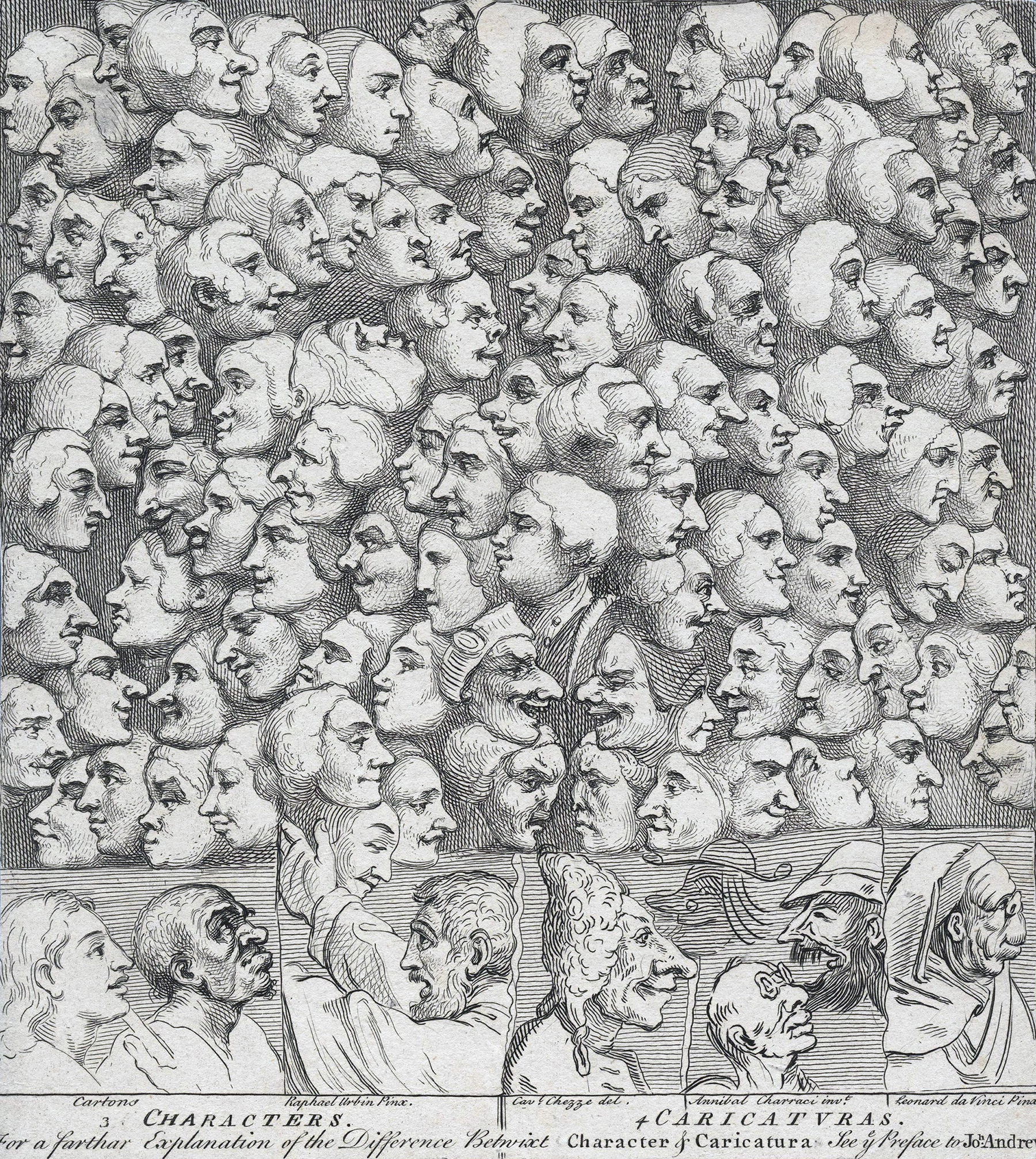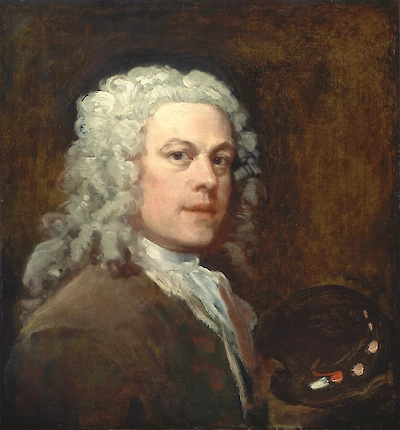

William Hogarth
A printmaker analyzes taste — and beauty comes out on top
1697 – 1764Forms of magnitude, although ill-shaped, will however, on account of their vastness, draw our attention and raise our admiration.
Hugh shapeless rocks have a pleasing kind of horror in them, and the wide ocean awes us with its vast contents; but when forms of beauty are presented to the eye in large quantities, the pleasure increases on the mind, and horror is softened into reverence.
How solemn and pleasing are groves of high grown trees, great churches, and palaces? Has not even a single spreading oak, grown to maturity, acquired the character of the venerable oak?
Windsor castle is a noble instance of the effect of quantity. The hugeness of its few distinct parts strikes the eye with uncommon grandeur at a distance, as well as near. It is quantity, with simplicity, which makes it one of the finest objects in the kingdom, though void of any regular order of architecture.
The Facade of the old Louvre at Paris is also remarkable for its quantity. This fragment is allowed to be the finest piece of building in France, though there are many equal, if not superior, to it in all other respects, except that of quantity.
Who does not feel a pleasure when he pictures in his mind the immense buildings which once adorned the lower Egypt, by imagining the whole complete, and ornamented with colossal statues?
Elephants and whales please us with their unwieldy greatness. Even large personages, merely for being so, command respect : quantity is an addition to the person which often supplies a deficiency in his figure.
The robes of state are always made large and full, because they give a grandeur of appearance, suitable to the offices of the greatest distinction. The judge’s robes have an awful dignity given them by the quantity of their contents, and when the train is held up, there is a noble waving line descending from the shoulders of the judge to the hand of his train-bearer. So when the train is gently thrown aside, it generally falls into a great variety of folds, which again employ the eye, and fix its attention.
The grandeur of the Eastern dress, which so far surpasses the European, depends as much on quantity as on costliness.
In a word, it is quantity which adds greatness to grace. But then excess is to be avoided, or quantity will become clumsy, heavy, or ridiculous.
The full-bottom wig, like the lion’s mane, has something noble in it, and adds not only dignity, but sagacity to the countenance: plate 9, but were it to be worn as large again, it would be- come a burlesque; or were an improper person to put it on, it would then too be ridiculous.
When improper, or incompatible excesses meet, they always excite laughter; more especially when the forms of those excesses are inelegant, that is, when they are composed of unvaried lines.
For example, figure 1, plate 10, represents a fat grown face of a man, with an infant’s cap on, and the rest of the child’s dress stuffed, and so well placed under his chin, as to seem to belong to that face. This is a contrivance I have seen at Bartholomew Fair, which always occasioned a roar of laughter. The next illustration, figure 2, plate 10, is of the same kind, a child with a man’s wig and cap on. In these you see the ideas of youth and age jumbled together, in forms without beauty.
So a Roman general, figure 1, plate 11, dressed by a modern tailor and peruke-maker, for tragedy, is a comic figure. The dresses of the times are mixed, and the lines which compose them are straight or only round.
Dancing-masters, representing deities, in their grand ballets on the stage, are no less ridiculous. See the Jupiter, figure 3, plate 10, Nevertheless custom and fashion will, in length of time, reconcile almost every absurdity whatever, to the eye, or make it overlooked.
It is from the same joining of opposite ideas that make us laugh at the owl and the ass, for under their awkward forms, they seem to be gravely musing and meditating, as if they had the sense of human beings.
A monkey too, whose figure, as well as most of his actions, so oddly resembles the human, is also very comical; and he becomes more so when a coat is put on him, as he then becomes a greater burlesque on the man.
There is something extremely odd and comical in the rough shock dog. The ideas here connected are the inelegant and inanimate figure of a thrum mop, or muff, and that of a sensible, friendly animal : which is as much a burlesque of the dog, as the monkey, when his coat is on, is of the man.
What can it be but this inelegance of the figure, joined with impropriety, that makes a whole audience burst into laughter, when they see the miller’s sack, in Dr. Faustus, jumping across the stage? Were a well-shaped vase to do the same, it would equally surprise, but not make everybody laugh, because the elegance of the form would prevent it.
For when the forms, thus joined together, are each of them elegant, and composed of agreeable lines, they will be so far from making us laugh, that they will become entertaining to the imagination, as well as pleasing to the eye. The sphinx and siren have been admired and accounted fundamental in all ages. The former represents strength and beauty joined; the latter, beauty and swiftness, in pleasing and graceful forms.
The griffin, a modem hieroglyphic, signifying strength and swiftness, united in the two noble forms of the lion and eagle, is a grand object. So the antique centaur has a savage greatness as well as beauty.
These may be said to be monsters, it is true, but then they convey such noble ideas, and have such elegance in their forms, as greatly compensates for their being unnaturally joined together.
I shall mention but one more instance of this sort, and that the most extraordinary of all, which is an infant’s head of about two years old, with a pair of duck’s wings placed under its chin. supposed always to be flying about, and singing psalms, figure 7, plate 8.
A painter’s representation of heaven would be nothing without swarms of these little inconsistent objects, flying about, or perching on the clouds; and yet there is something so agreeable in their form, that the eye is reconciled, and overlooks the absurdity, and we find them in the carving and painting of almost every church. St. Paul’s Cathedral is full of them.
As the foregoing principles are the very ground- work of what is to follow, we will, in order to make them the more familiar to us, just speak of them in the way they are daily put in practice, and may be seen, in every dress that is worn; and we shall find not only that ladies of fashion, but that women of every rank, who are said to dress prettily, have known their force, without considering them as principles.
I. Fitness is first considered by them, as knowing that their dresses should be useful, commodious, and fitted to their different ages; or rich, airy, and loose, agreeable to the character they would give out to the public by their dress.
II. Uniformity is chiefly complied with in dress on account of fitness, and seems to be extended not much farther than dressing both arms alike, and having the shoes of the same color. For when any part of dress has not the excuse of fitness or propriety for its uniformity of parts, the ladies always call it formal.
For which reason, when they are at liberty to make what shapes they please in ornamenting their persons, those of the best taste choose the irregular as the more engaging: for example, no two- patches are ever chosen of the same size, or placed at the same height; nor a single one in the middle of a feature, unless it be to hide a blemish. So a single feather, flower, or jewel, is generally placed on one side of the head; or if ever put in front, it is turned awry, to avoid formality.
It was once the fashion to have two curls of equal size, stuck at the same height close upon the forehead, which probably took its rise from seeing the pretty effect of curls falling loosely over the face.
A lock of hair falling thus across the temples, and by this means breaking the regularity of the oval, has a pleasing effect, but being paired in so stiff a manner, as they formerly were, they lost the desired effect, and ill deserved the name of favorites.
III. Variety in dress, both as to color and form, is the constant study of the young and gay — But then,
IV. That tawdriness may not destroy the proper effect of variety, simplicity is called in to restrain its superfluities, and is often very artfully made use of to set native beauty off to more advantage. I have not known any set of people that have more excelled in this principle of simplicity, or plainness, than the Quakers.
V. Quantity, or fulness in dress, has ever been a darling principle; so that sometimes those parts of dress, which would properly admit of being extended to a great degree, have been carried into such strange excesses, that in the reign of Queen Elizabeth a law was made to put a stop to the growth of ruffs: nor is the enormous size of the hoops at present a less sufficient proof of the extraordinary love of quantity in dress, beyond that of convenience or elegance.
VI. The beauty of intricacy lies in contriving winding shapes, such as the antique lappets belonging to the head of the sphinx, figure 3, plate 6, or as the modern lappet, when it is brought before. Every part of dress, that will admit of the application of this principle, has an air, as it
is termed, given to it thereby; and although it requires dexterity and a taste to execute these windings well, we find them daily practiced with success.
This principle also recommends modesty in dress, therefore the body and limbs should all be covered, and little more than certain hints be given of them through the clothing.
The face indeed will bear a constant view, yet always entertain and keep our curiosity awake, without the assistance either of a mask or veil; because vast variety of changing circumstances keeps the eye and the mind in constant play, in following the numberless turns of expression it is capable of. How soon does a face that wants expression grow insipid, though it be ever so pretty.